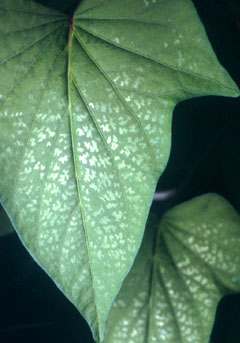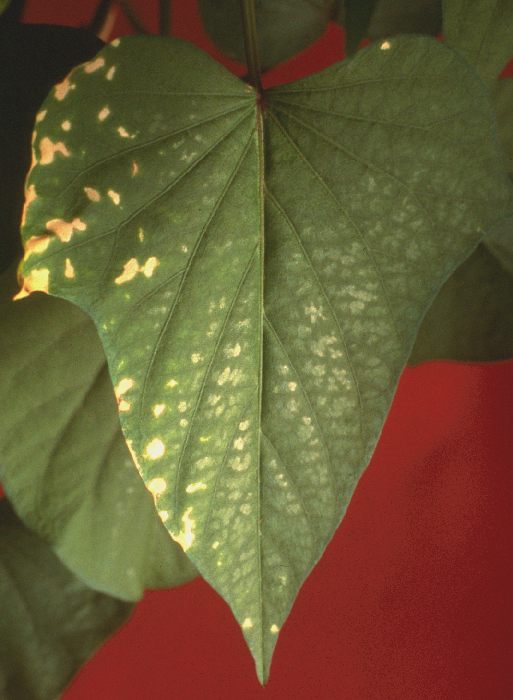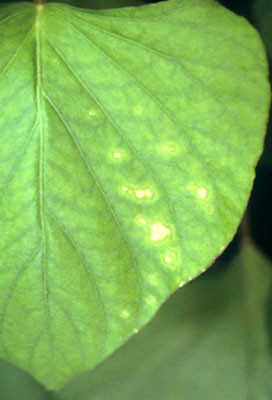|
Molybdenum
(Mo) is unusual among the micronutrients
in becoming less available to plants at low soil pH.
Therefore, molybdenum deficiency is
usually associated with acid soils (pH
<5.5), particularly those which are geologically old and highly leached.
Molybdenum deficiency has not been reported in sweetpotato crops to date. As
soils low in molybdenum are often also low in phosphorus and sulfur, molybdenum
may not be apparent unless phosphorus and sulfur deficiencies have been
corrected by fertilisation.
Molybdenum is required by plants in very
small quantities. Its main (and possibly only) function in non-leguminous plants
is as a component of the enzyme nitrate reductase, which is essential for the
metabolism of nitrate, the main form of plant-available nitrogen in most soils.
Therefore molybdenum deficient plants may appear as if they are deficient in
nitrogen, having general chlorosis and stunted
growth. Symptoms unlike those of nitrogen deficiency may occur as a result of
nitrate accumulation to toxic levels in the tissue.
Although molybdenum deficiency has not
been described in field-grown sweetpotato, symptoms resembling those of N
deficiency are expected. Such symptoms would include a general pale green
colour, stunted growth with small leaf size, and possible reddening of veins on
the young leaves.
In plants grown in solution culture, the
following symptoms were associated with a mild growth reduction from molybdenum
deficiency. In cultivar Wanmun, older leaves developed silvery patches over
interveinal tissue, as a result of the upper epidermis separating from the
underlying tissue. Eventually these patches became necrotic, but
necrosis did not spread readily from the isolated interveinal patches.
In cultivar Beerwah Gold, the young to recently mature leaves displayed a mild
interveinal chlorosis, with some interveinal areas becoming necrotic. In
cultivar Hawaii, chlorosis was more uniform, and the recently mature leaves
commonly developed a marginal scorch,
especially at the tips of lobes.
Molybdenum deficiency may induce symptoms
similar to those of nitrogen deficiency, as molybdenum is required for the
assimilation of nitrate taken up by the plant. Necrosis (dead tissue) on the
margins and interveinal areas of older leaves may bear some resemblance to
salinity damage or boron toxicity. However, these disorders generally cause much
more extensive necrosis than has been seen in the case of molybdenum deficiency,
and are not usually associated with acid soils.
From solution culture studies, the
critical concentration for deficiency of molybdenum was found to be
approximately 0.2 mg Mo/kg in the 7th to 9th youngest leaf blades. Equivalent
leaves from healthy plants contained 0.5 - 7 mg Mo/kg.
As molybdenum is required for metabolism
of nitrate, deficiency of molybdenum can result in accumulation of nitrate in
the plant tissues. Measurements of sap nitrate concentration have been used to
distinguish molybdenum deficiency from nitrogen deficiency in a number of crops.
A simple, semi-quantitative measurement of sap nitrate can be performed using
nitrate test strips, such as those manufactured by Merk. Reagent-impregnated
paper is mounted on the plastic strips, and changes from white to deep purple
when wet with a solution containing nitrate, over the range 10-500 ppm.
Sweetpotato sap can be tested by cutting through a stem or petiole, and applying
the side edge of the paper to the droplet of sap which exudes from the cut,
allowing the moisture to move in by capillary action. The sap should not be
applied directly to the paper surface, as it will stain darkly. Sap from
molybdenum-deficient plants will cause a strong colour change, while that from
nitrogen-deficient plants produces little if any change. Sap from healthy plants
will usually give a weak to moderate reaction. Note that sulfur deficiency may
also increase sap nitrate levels.
Cultural control
Molybdenum deficiency is relatively
easily corrected, either by the application of small quantities of molybdenum to
the soil, or by raising the soil pH. Application of sodium molybdate or ammonium
molybdate at rates of 0.2-0.3 kg Mo/ha should be sufficient to correct the
disorder in most situations, and may be effective for several years. Sodium
molybdate may also be applied as a foliar spray. A solution of 50 g sodium
molybdate/100 L water has proven successful with other crops such as sunflower.
Some commercially-available fertiliser mixtures also contain molybdenum.
Liming to raise the soil pH above 5.5 is
usually effective in alleviating molybdenum deficiency, and may improve
conditions for crop growth in other ways also, such as through improved
availability of phosphorus and alleviation of manganese or aluminium toxicity.
Blamey, F.P.C., Edwards, D.G. and Asher, C.J. 1987. Nutritional Disorders of Sunflower.
Department of Agriculture, University of Queensland, St Lucia, Queensland,
Australia. 72 pp.
Johnson, C.M. 1966. Molybdenum. In: Chapman, H.D. (ed.)
Diagnostic criteria for plants and soils. Dept of Soils and Plant Nutrition,
University of California Citrus Research Centre and Agricultural Experiment
Station, Riverside, California.
McDonald, W.J. 1978. Molybdenum - if itís short yields will
suffer. Sunflower 2, 22.
OíSullivan, J.N., Asher, C.J. and Blamey, F.P.C. 1997.
Nutrient Disorders of Sweet Potato. ACIAR Monograph No. 48, Australian Centre
for International Agricultural Research, Canberra, 136 p.
Ulrich, A. 1993. Potato. In: Bennett, W.F. (ed), Nutrient deficiencies and toxicities in
crop plants. APS Press, St. Paul, Minnesota, USA. pp 149-156.
Contributed by:
Jane O'Sullivan |
Characteristics
and occurrence
Symptoms
Confusion
with other symptoms
Diagnostic
tests
Management
References

Silvery patches over tissues between veins (J.
O'Sullivan).

Pale necrotic spots of irregular shape following
silvery spots (J. O'Sullivan).

Interveinal chlorosis and necrotic spots on a mature leaf (J.
O'Sullivan).

General chlorosis and marginal necrosis, especially
on lobe tips (J. O'Sullivan). |

